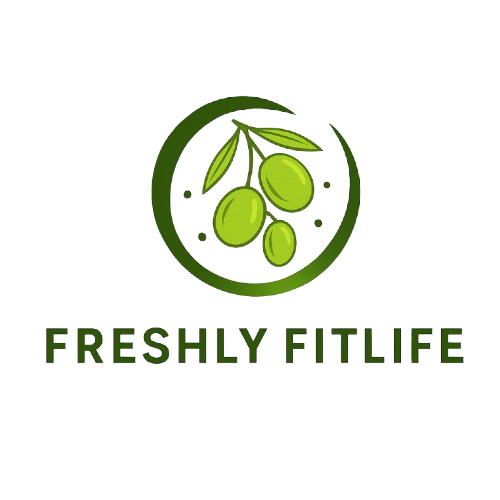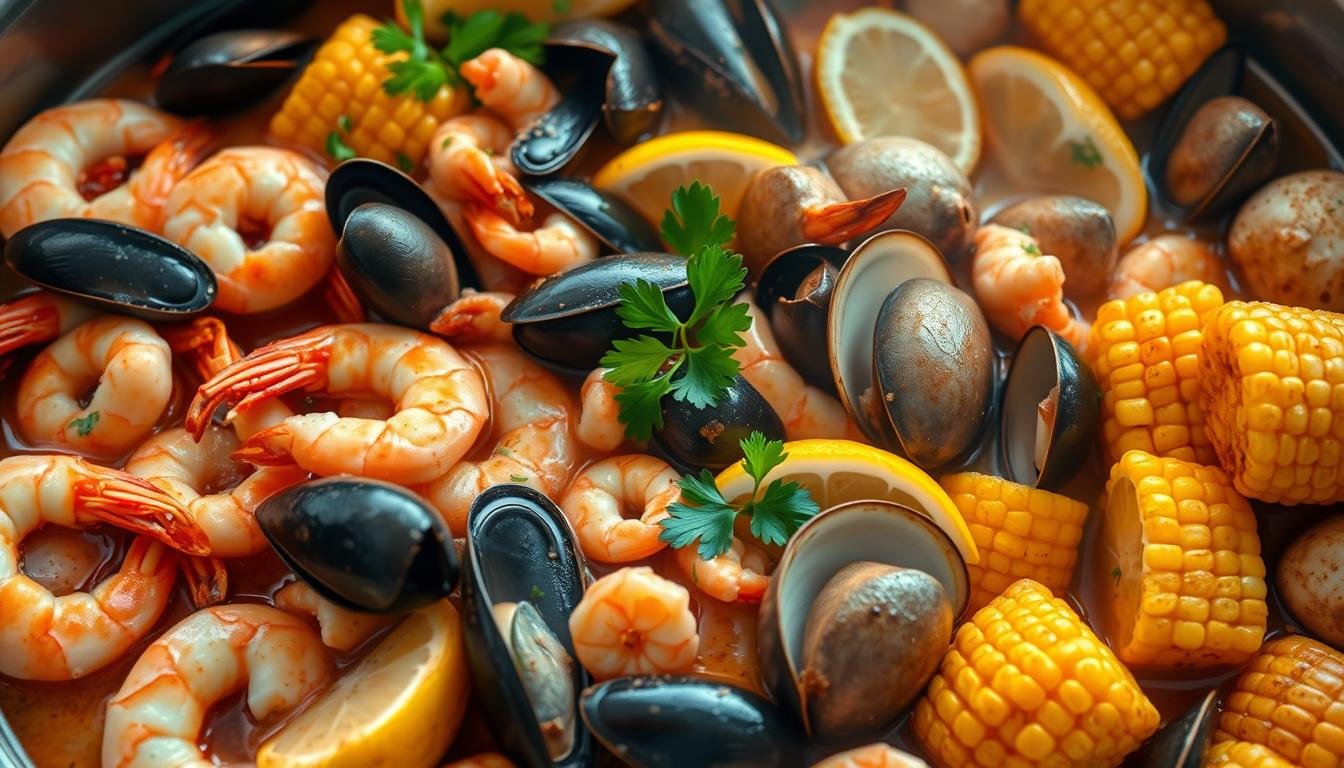Ever wondered if indulging in a Cajun seafood boil is as good for your body as it is for your taste buds? This flavorful feast, packed with shrimp, crab, and vibrant veggies, has taken the U.S. by storm. But does it fit into a balanced diet?
Loaded with omega-3s, vitamins, and antioxidants, these boils offer surprising perks. Yet, concerns about sodium and calories linger. Let’s crack the shell on what makes this dish a nutritious seafood meal—or a occasional treat.
Key Takeaways
- Cajun seafood boils combine shellfish and vegetables for a protein-rich dish.
- Rich in omega-3s, vitamins B12 and D, and essential minerals like zinc.
- Portion control matters—servings range from 500 to 800 calories.
- Spices and veggies add antioxidants, per a Louisiana State University study.
- Balance is key due to sodium content in seasonings.
Understanding Seafood Boils: A Flavorful Tradition
Born from Louisiana’s bayous, seafood boils tell a story of community and flavor. This Cajun seafood boil tradition dates back to 18th-century Acadian settlers who turned local catches into feasts. Today, it’s a symbol of Southern gatherings, where pots bubble with spice and laughter.
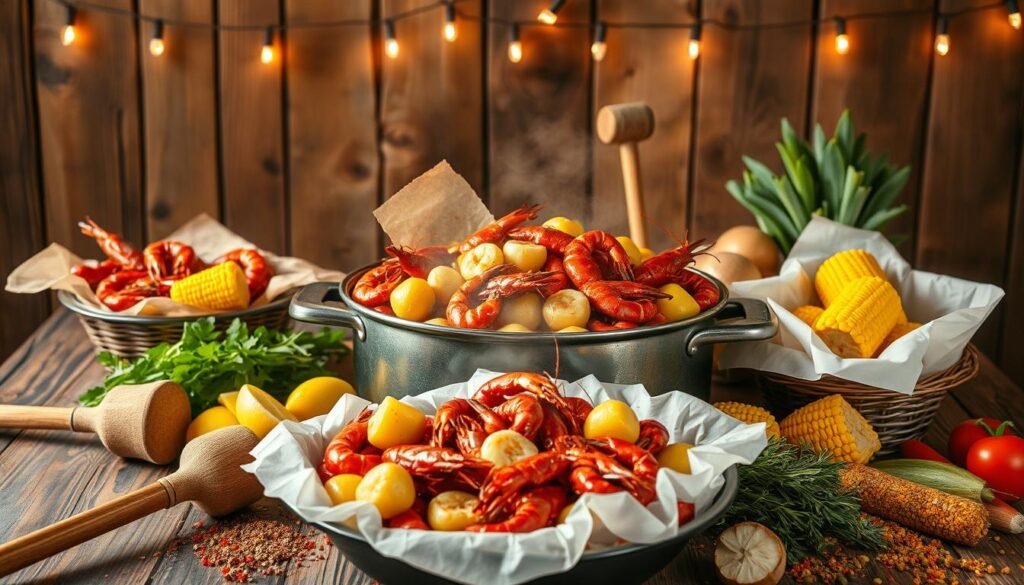
Cultural Roots and Communal Spirit
Coastal communities perfected the art of cooking shellfish outdoors. Large pots became the centerpiece of family reunions and festivals. Chef Paul Prudhomme once noted, “The magic isn’t just in the spices—it’s in the shared experience.”
Classic Ingredients
A traditional seafood boil combines:
- Shellfish: Shrimp, crab, or crawfish (the star of Louisiana boils)
- Vegetables: Corn, potatoes, and onions absorb the spicy broth
- Spices: Cajun or Creole blends with paprika, garlic, and cayenne
Regional Twists Across the U.S.
From Texas crawfish boils to New England clambakes, each region adds its flair. The Pacific Northwest swaps in Dungeness crab, while Lowcountry boils feature andouille sausage and Old Bay seasoning. Even portions vary—Louisiana’s record-breaking 5,000-pound crawfish boil proves bigger is sometimes better!
Nutritional Breakdown of Seafood Boil Components
Digging into the nutrition behind seafood boils reveals surprising benefits. Each ingredient plays a role, from muscle-building shellfish to fiber-packed veggies. Let’s dissect the key players.

Shellfish: Protein Powerhouses
Shrimp and crab steal the spotlight with lean protein. A 3oz serving of shrimp packs 20g protein—rivaling chicken—for just 84 calories. Crab adds zinc, crucial for immunity and wound healing.
Oysters, though less common, bring exceptional vitamins, including a day’s worth of vitamin D per serving. Compare shellfish nutrition below:
| Ingredient (3oz) | Protein | Key Nutrient |
|---|---|---|
| Shrimp | 20g | Low fat (1g) |
| Crab | 16g | Zinc (3.8mg) |
| Oysters | 9g | Vitamin D (168IU) |
Vegetables: Fiber and Antioxidants
Corn and potatoes aren’t just fillers—they’re nutrient boosters. One ear of corn delivers 4.2g fiber, while red potatoes offer 27mg vitamin C. Leave the skins on for extra potassium, supporting heart health.
Johns Hopkins research highlights spices like cayenne and paprika in boils for their anti-inflammatory properties. Yet, balance is key.
Seasonings: The Sodium Trap
Commercial seasoning packets can hide 1,500–2,300mg sodium per serving—nearing the daily limit. Swap half the mix with fresh herbs (thyme, bay leaves) to cut salt without losing flavor.
Pro tip: Use low-sodium broth as your boiling liquid. It slashes sodium while keeping the dish aromatic.
Key Health Benefits of Seafood Boils
Beyond bold flavors, shellfish feasts pack a nutritional punch. Loaded with omega-3 fatty acids, lean protein, and critical vitamins minerals, these dishes support everything from brain function to muscle repair. Here’s why nutritionists call them heart-healthy seafood options.

Omega-3s: Brain and Heart Boosters
Lobster and crab deliver 200–500mg omega-3s per serving. These fats, especially DHA and EPA, sharpen cognition and slash heart disease risk. The American Heart Association recommends two weekly servings for optimal heart health.
Athletes like marathoner Eliud Kipchoge prioritize shellfish post-training. “The combo of protein and omega-3s speeds recovery,” he notes. Plant sources like flaxseeds offer ALA omega-3s, but shellfish provide the more bioavailable DHA/EPA forms.
Protein That Builds and Preserves
Shellfish protein absorbs 30% faster than plant-based options, per a Journal of Nutrition study. Shrimp’s 20g protein per 3oz rivals chicken—with just 1g fat. This makes it ideal for maintaining muscle mass during aging or weight loss.
Vitamin and Mineral Treasure Trove
One crab portion covers 400% of daily B12 needs, fighting anemia fatigue. Oysters supply zinc for immune defense, while clams offer iron for energy. Compare key nutrients:
| Shellfish (3oz) | Top Nutrient | % Daily Value |
|---|---|---|
| Crab | Vitamin B12 | 400% |
| Oysters | Zinc | 200% |
| Clams | Iron | 24% |
Spices like cayenne add antioxidants, but the real health benefits come from the ocean’s bounty. Balance indulgence with portion awareness to reap these rewards.
Are Seafood Boils Healthy? The Balanced Truth
Nutritionists often weigh the pros and cons of shellfish-based feasts like seafood boils. While packed with essential nutrients, these flavorful gatherings require mindful eating strategies to maximize their health benefits.
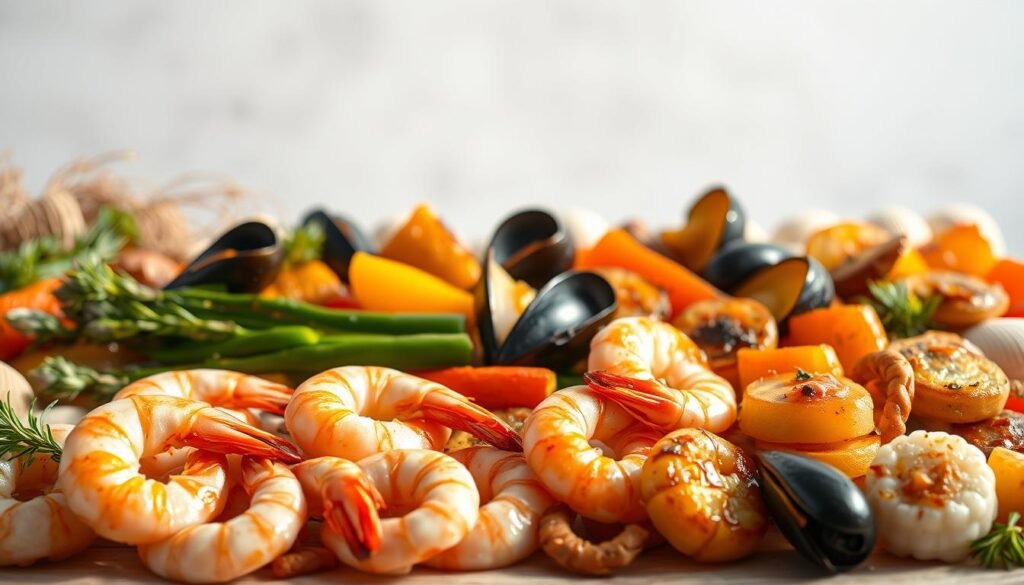
Nutrient Density and Balanced Macros
Harvard School of Public Health praises shellfish boils for their macro balance. A 6oz crawfish portion delivers just 70 calories with 14g protein, while the same amount of sausage adds 300+ calories. Compare key ingredients:
| Ingredient (6oz) | Calories | Protein |
|---|---|---|
| Crawfish | 70 | 14g |
| Andouille Sausage | 330 | 12g |
| Shrimp | 84 | 20g |
Corn and potatoes add fiber, creating what MyPlate.gov calls a “complete plate” when paired with shellfish. This contrasts with typical BBQ meals that often lack vegetable diversity.
Sodium and Cholesterol Considerations
One cup of boil broth can pack 800mg sodium—35% of the AHA’s daily limit. However, NIH research clarifies that dietary cholesterol in shellfish impacts blood levels less than saturated fats.
Chef Marcus Samuelsson advises: “Swap smoked sausage for chicken apple sausage to cut both sodium and saturated fat by half.” Herbs like thyme can replace 30% of seasoning mix without sacrificing flavor.
Portion Size Matters
Visual guides help: A palm-sized portion of shellfish (3-4oz) meets protein needs without excess calories. Adding extra corn and potatoes stretches servings while keeping the meal balanced.
For diet-conscious diners, focusing on shrimp over sausage and measuring spices can transform a boil from indulgent to nutrient-dense. The key lies in customization—the same pot can cater to both fitness buffs and flavor seekers.
Potential Health Concerns to Consider
While shellfish boils offer impressive nutrition, certain health factors deserve attention. From sodium levels to allergy risks, being informed helps you enjoy these meals safely.
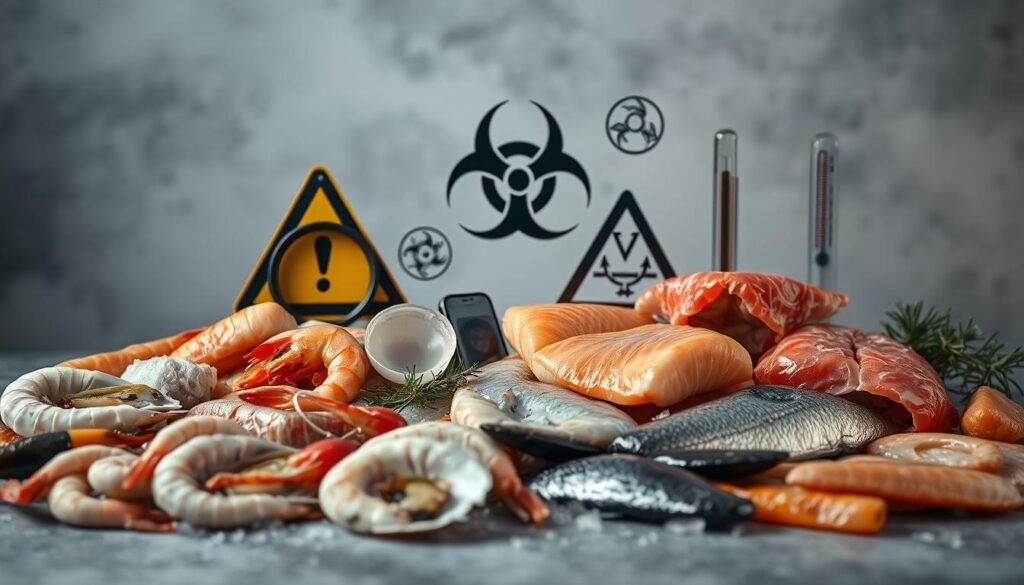
Navigating Sodium and Blood Pressure
Traditional boils can pack a day’s worth of sodium in one meal. The CDC notes that 25% of Americans have hypertension, making salt intake a critical risk. Excess sodium strains kidneys and elevates blood pressure.
Chef Vivian Howard suggests: “Cut pre-mixed spices by half and boost flavor with citrus zest or smoked paprika.” Opting for low-sodium seafood preparation methods, like steaming with herbs, reduces salt without sacrificing taste.
Shellfish Allergies: A Serious Consideration
The FDA ranks shellfish among the top nine food allergens. Reactions range from hives to life-threatening anaphylaxis. Cross-contamination is common—shared pots or utensils can trigger responses.
For allergy-friendly alternatives, try:
- Chicken or turkey sausage as a protein swap
- Mushrooms for a umami-rich, shellfish-free option
- Vegetable broth instead of seafood stock
Environmental Contaminants in Seafood
Mercury and microplastics occasionally appear in shellfish. The EPA advises pregnant women to limit high-mercury species like tilefish. Gulf shrimp may contain microplastics, but wild-caught varieties generally test lower than farmed.
Refer to the EWG’s Safe Seafood Choices chart for dietary guidance. Proper cooking (internal temps of 145°F) also neutralizes pathogens like Vibrio vulnificus, per CDC guidelines.
“Variety is key—rotate shrimp, crab, and scallops to minimize contaminant exposure.”
By understanding these health nuances, you can savor shellfish boils wisely. For more tips, explore low-sodium seafood preparation methods.
Making Healthier Seafood Boil Choices
Modern takes on coastal classics can double the nutrition without losing flavor. With smart ingredient swaps and cooking methods, these feasts become heart-smart meals. Here’s how chefs and dietitians upgrade traditional recipes.

Lean Protein Picks
Not all shellfish pack equal calories. For maximum protein with minimal fat:
- Scallops (20g protein, 1g fat per 3oz)
- Shrimp (0g fat when boiled)
- Lobster (1g fat per 100g)
Chef Eric Ripert suggests: “Swap sausage for mushrooms—they add umami with 90% less saturated fat.” Tomato paste also deepens flavor without extra calories.
Salt-Smart Seasoning Tricks
Traditional spice blends can overwhelm daily sodium limits. Try these alternatives:
- Toast whole spices (cumin, coriander) to intensify flavor
- Use a 2:1 lemon juice to vinegar ratio for acidity
- Marinate shellfish in citrus before cooking
This cuts sodium by 40% while keeping the dish vibrant. A dash of smoked paprika mimics Cajun depth.
Veggie Power Plays
Zucchini adds 33% more nutrients than corn per cup. For vegetables with crunch:
- Spiralized carrot “noodles” absorb broth beautifully
- Roasted Brussels sprouts add fiber
- Broccoli florets hold spice coatings well
Nutritionist Maya Feller notes: “Cruciferous veggies transform boils into complete meals.” Serve with olive oil instead of butter to save 40 calories per tablespoon.
Cooking Methods Compared: Nutritional Impact
The way you cook shellfish can make or break its nutritional value. Heat affects proteins, vitamins, and fats differently across cooking methods. Choosing the right technique preserves the health benefits while maximizing flavor.
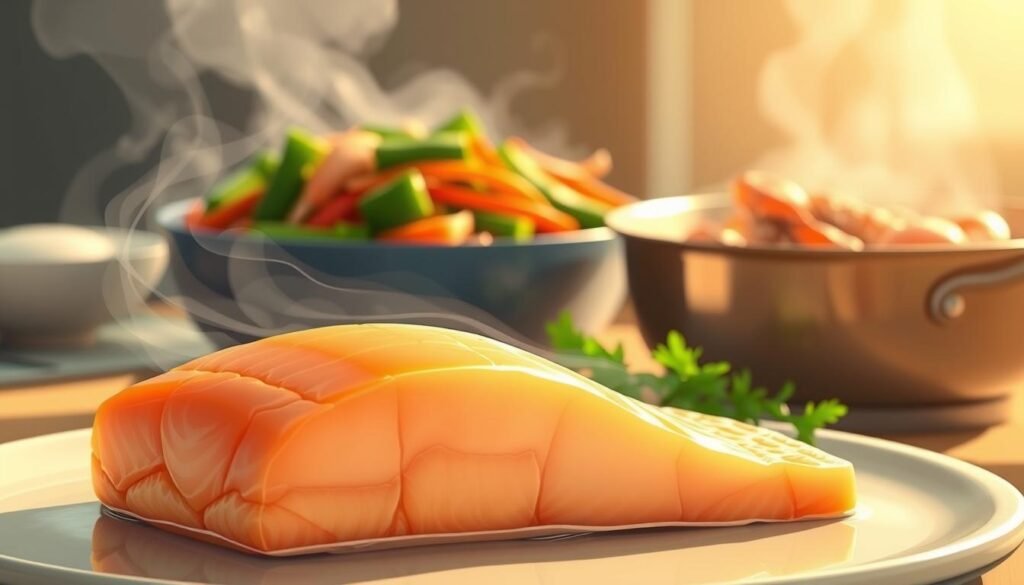
Boiling vs Frying: Fat and Vitamin Trade-Offs
Boiling retains 85% of vitamin C, while frying destroys over half. Water-soluble vitamins like B-complex also stay intact in simmering pots. Compare the nutritional differences:
| Method | Saturated Fat | Vitamin Retention |
|---|---|---|
| Boiling | 1g per serving | High (B/C vitamins) |
| Frying | 12g per serving | Moderate (50% loss) |
Chef Thomas Keller advises: “Always save the boiling liquid—it’s packed with leached nutrients perfect for soups.” This aligns with low-sodium seafood preparation methods that reuse broth.
Steaming: The Gentle Alternative
Cornell University research shows steaming preserves 90% of shellfish nutrients. Bamboo baskets allow even cooking without waterlogging. Key advantages:
- No added fats from oils or butter
- Retains delicate textures better than boiling
- Minimal vitamin loss compared to dry-heat methods
Grilling Smartly: Flavor Without Risk
High-heat grilling above 375°F forms harmful HCAs (heterocyclic amines). Reduce risks with:
- Marinating in lemon juice or vinegar (cuts HCA formation by 90%)
- Using infrared grills (lower flare-ups than charcoal)
- Flipping frequently to prevent charring
Try this nutrient-preserving rub for shrimp: 2 tsp smoked paprika + 1 tsp garlic powder + 1/4 cup olive oil. It adds depth without carcinogens.
Adapting Seafood Boils for Special Diets
Special dietary needs shouldn’t mean missing out on bold tastes. With smart swaps, everyone can enjoy a flavorful feast. Whether gluten-free, plant-based, or low-carb, boils adapt seamlessly.
Plant-Powered Alternatives
King oyster mushrooms mimic scallops when sliced and seared. For a vegan “crab” boil, shred jackfruit with Old Bay and lemon. Tempeh outshines seitan with 20g protein per serving and fewer carbs.
Try these butter swaps:
- Avocado oil for richness
- Tahini for a nutty depth
- Cashew cream for silky texture
Gluten-Free Flavor Boosts
Traditional seasonings often hide wheat. Certified gluten-free brands like Primal Palate or Simply Organic ensure safety. Tamari replaces soy sauce, adding umami without gluten.
| Ingredient | Gluten-Free Swap |
|---|---|
| Soy Sauce | Coconut aminos |
| Beer (in broth) | Hard cider |
Keto and Low-Carb Twists
Konjac root stands in for potatoes with 3g net carbs per cup. Cauliflower florets steamed with nori flakes mimic clams. For a keto-friendly broth, use bone stock and extra spices.
“Cruciferous vegetables transform boils into complete meals without the carbs.”
Conclusion: Enjoying Seafood Boils Responsibly
Mindful choices turn coastal classics into wholesome meals. The Academy of Nutrition and Dietetics confirms: 80% of nutritionists endorse monthly seafood boil enjoyment when balanced with fresh, quality ingredients.
Prioritize health by sourcing shellfish from trusted suppliers. Pair feasts with an active lifestyle—think post-meal walks or beach volleyball. Seasonal picks like summer corn or fall sweet potatoes add variety.
For your next gathering:
- Use a portion cheat sheet (3–4oz protein + 1 cup veggies)
- Celebrate flavors with herbs instead of excess salt
- Print our mindful seafood consumption guide
Final tip: “Moderation, not elimination, keeps traditions alive and plates vibrant.” Now, grab that pot and cook with confidence!
